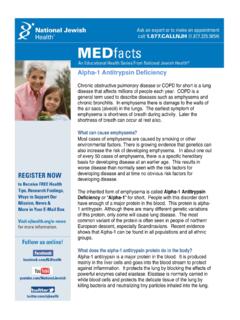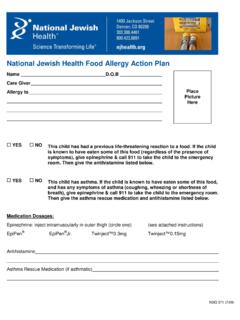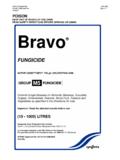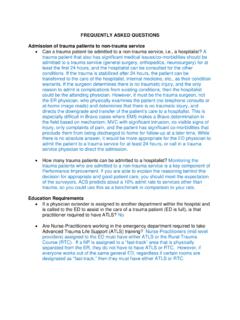Transcription of BRAVO® pH Monitoring - National Jewish Health
1 bravo pH Monitoring What is a bravo pH Monitoring study? Your doctor has suggested you have a bravo pH Monitoring study as part of the evaluation at National Jewish Health . This study measures the amount of esophageal reflux you have. Gastroesophageal reflux is the backward flow or reflux of food and acid from the stomach into the esophagus. The esophagus is the tube that takes food from your mouth into your stomach. A bravo pH Monitoring study will help identify if you have increased amounts of reflux and if it is causing your symptoms.
2 Your doctor has also suggested you have an EGD (Esophagogastroduodenoscopy) as part of the evaluation at National Jewish . An EGD allows the doctor to look inside the esophagus, stomach and small intestine. These are the upper portions of your digestive system. Your doctor will use a small flexible tube, starting at your mouth, to see inside your body. Your doctor will place the bravo pH Monitoring device in your esophagus during the EGD. The results of the study will help your doctor determine your diagnosis and the best treatment for you.
3 How do you get ready for the test? In addition to the EGD instructions, please follow these instructions closely. If this is not done, we will need to reschedule the study. Planning ahead: Inform your doctor if you have an implanted cardiac device or any medical conditions. Inform your doctor of all the medicines you take. Certain medicines may need to be stopped before the test. Blood thinners such as Coumadin, Plavix or Lovenox will need to be stopped before your EGD and bravo . Ask the doctor who prescribes these medicines when to stop them.
4 You will also need to come to the clinic for a blood test (PT-INR) the day before your EGD. Let your doctor know if you take insulin. The doctor who prescribes your insulin may have you change the dose the day before and the day of the EGD. One of the next 2 boxes will be checked. If not, please call us so you know what to do. Do take your reflux/antacid medicines as your doctor has prescribed. Do Not take your reflux/antacid medicines. Check with your doctor before you stop the medicine. Stop these medicines at least 3 days before your appointment: Zantac (Ranitidine), Tagamet (Cimetidine), Axid (Nizatidine), Pepcid (Famotidine), Reglan (Metoclopramide) Stop these medicines at least 7 days before your appointment: Prilosec (Omeprazole), Prevacid (Lansoprazole), Nexium (esonephazole), Protonix , Pantoloc (pantoprazole), Aciphex (rabeprazole).
5 Continue to take all your other medicine as you usually do. Ask a companion (family member or friend) to pick you up after your EGD and bravo and stay with you during the night. You will not be able to drive or take a taxi home after the test. Wear loose fitting clothing. You may need to change into a patient gown (from the waist up) during the test. Midnight the night before the study: Do not eat or drink anything after midnight, the night before the EGD with bravo . The day of the study: Do not eat food after midnight.
6 You may have clear liquids until 4 hours prior to the procedure. Clear liquids include Gatorade, strained fruit juice (no citrus), soda, popsicles without fruit or cream, gelatin without fruit, bullion, coffee or tea (without milk). Avoid drinking only water. Do not take the medicines your doctor has asked you to hold. Do take any heart, blood pressure or seizure medicine at least 2 hours before leaving for the test with a few sips of water. Do bring your inhaled medicine with you. If you have sleep apnea, bring your CPAP mask and machine with you.
7 If you are diabetic, please bring your glucose meter, test strips, and fast acting glucose source (either glucose tablets or gel). Check in at the front desk at the time your test is scheduled. What is done during the test? When you arrive the nurse will explain what will be done before, during and after the EGD and bravo placement. If you have questions, please ask. The nurse will start an IV. The IV will be used to give medicine to make you sleepy and relaxed. You will be monitored closely during the study. You will lie down during the EGD.
8 A mouthpiece will help you keep your mouth open. During the bravo study a special capsule will be attached to the lower lining of your esophagus. The capsule is about the size of a pencil eraser tip. The bravo capsule will be placed in the esophagus during the EGD. Once the EGD and bravo placement is done you will rest. You will be sleepy in the beginning. Your doctor will determine when you are able to go home. The bravo capsule will stay attached to the esophagus during the study. Several days after the study the capsule will naturally detach from the esophagus and will pass through your digestive tract.
9 The bravo capsule measures pH levels in the esophagus. The capsule will send the pH levels via signals to a bravo receiver during the study. The receiver is about the size of a cell phone and can be attached to your waistband or belt. You will need to keep the receiver within 3 feet at all times for the capsule signals to be sent to the receiver. You can shower or bathe, but make sure the receiver is within 3 feet of the capsule without getting wet. The receiver has buttons that you will push during the study. You will also be given a diary.
10 You will keep track of symptoms, when you eat, body position (lying down, sitting or standing) and peak flow measures using the buttons on the receiver and the diary. The nurse will show you how to us the bravo receiver and diary to monitor how you are doing during the study. It is important that you maintain all regular activities as much as possible during the study in order to obtain an accurate assessment of reflux through a "normal"48 hours. This includes maintaining typical meals, activities, exercise, sleep, etc., while the bravo capsule and receiver are in place.














